Garden Pests and Diseases for 4 US Zones
How to Prevent and Treat for Common Pests
This is an overview of common pests and diseases in some general climate zones and some preventive and treatment measures:
1. Mild Climates (e.g., Southern California, Florida):

Common Pests: Aphids, whiteflies, mealybugs, snails, slugs.
Common Diseases: Powdery mildew, botrytis (gray mold), root rot.
Prevention & Treatment:
Encourage natural predators like ladybugs and lacewings to control pests.
Regularly inspect plants and prune affected parts.
Use horticultural oil or neem oil to combat pests.
Improve air circulation to reduce fungal diseases.
Ensure proper watering practices to avoid root rot.
2. Temperate Climates (e.g., Northeast, Midwest):

Common Pests: Japanese beetles, slugs, caterpillars, scale insects.
Common Diseases: Tomato blight, rust, downy mildew.
Prevention & Treatment:
Handpick or use traps for large insects like Japanese beetles.
Apply organic pesticides like Bt (Bacillus thuringiensis) for caterpillars.
Use copper-based fungicides for fungal diseases.
Rotate crops to prevent soil-borne diseases.
Water plants at the base to avoid wetting foliage.
3. Hot & Arid Climates (e.g., Southwest):

Common Pests: Spider mites, aphids, grasshoppers.
Common Diseases: Sunscald, blossom end rot.
Prevention & Treatment:
Regularly spray water on plants to deter spider mites and aphids.
Introduce beneficial insects like ladybugs to control pests.
Provide shade during extreme heat to prevent sunscald.
Mulch and maintain consistent soil moisture to prevent blossom end rot.
4. Cold & Northern Climates (e.g., Northern Midwest, New England):

Common Pests: Cabbage worms, Colorado potato beetles, slugs.
Common Diseases: Late blight, powdery mildew.
Prevention & Treatment:
Use row covers to protect plants from pests.
Handpick insects like cabbage worms and Colorado potato beetles.
Promote good air circulation to prevent fungal diseases.
Apply fungicides preventively during wet periods.
Clean up garden debris in the fall to reduce overwintering pests.
A Few More Tips
• Remember that local factors such as microclimates, specific plants grown, and prevailing weather conditions can influence the types of pests and diseases you encounter.
• Integrated Pest Management (IPM) is a sustainable approach that combines prevention, monitoring, and appropriate treatment to manage pests and diseases effectively.
• Always follow the instructions on the labels of any pesticides or fungicides you use and consider environmentally friendly alternatives whenever possible.
• Additionally, local cooperative extension offices or gardening clubs can provide region-specific information and guidance.
REMEMBER: Please store all poisons and harmful substances in a safe place out of the reach of children.






